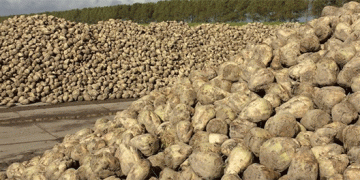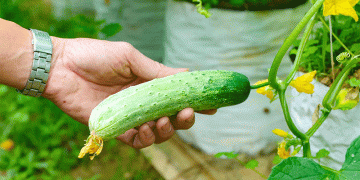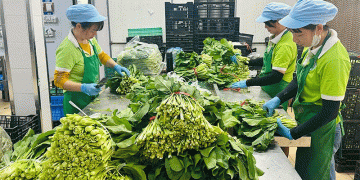More Bangladeshi farmers are growing vegetable crops instead of paddy as climate change results in less rainfall and groundwater.
For decades, Shafiqul Islam Babu grew rice on his land in northwest Bangladesh – until climate change made rainfall more erratic and overused groundwater began drying up in the mid-2000s.
As his rice harvest declined, so did his earnings.
In response, the 45-year-old farmer decided to grow cabbage on his land – a high-value crop that uses less water than rice, has plenty of buyers, and provides him with a steady income.
“I didn’t know what to do instead of paddy farming, which was my ancestor’s profession, (and) I had to maintain my family with my savings,” he said in an interview while cleaning weeds and dead leaves from his 20-hectare (49-acre) cabbage farm.
“Then, vegetable farming showed me a ray of hope.”Babu said he sold his entire cabbage crop ahead of harvest this year, with demand for the vegetable high in Dhaka, the capital. He managed to make about 215,000 taka ($2,000), up from the 80,000-odd taka he used to receive for his rice harvest.
Accelerating climate change impacts have led many farmers in Bangladesh’s Rajshahi district to swap rice for vegetables as they strive to make their business pay on an ever-hotter planet.
Eight years ago, rice was the region’s main crop – but now it is the “loser crop”, with vegetables from cabbage to gourds increasingly favoured as they need less water, produce higher yields and bring in more money, according to Shamsul Wadud, head of the district’s Department of Agricultural Extension.
Farmers in Rajshahi used to struggle to grow rice for two seasons a year, but many are now cultivating vegetables three or four times annually on the same land, Wadud explained.
“They are getting good prices (and) the production of vegetable crops has now increased many times,” he said.
Since 2009, the area of land dedicated to growing vegetables has almost quadrupled to about 78,500 hectares in Rajshahi, making it the nation’s largest vegetable-producing district, agriculture ministry figures show.
But it’s not just Rajshahi that is looking beyond rice.
Bangladesh’s agriculture minister Muhammad Abdur Razzaque said the government was aiming to use “all kinds of abandoned and sandy land” to expand vegetable production.
Sandy soil is considered superior for growing vegetables rather than rice because it requires less water and fertiliser, officials said.
Depleting groundwater
While some parts of Bangladesh have been experiencing record-breaking monsoon rains and flooding, drought is becoming increasingly common in the Barind region, which covers most of Rajshahi and some of Rangpur district.
The area’s annual average rainfall is about 1,100 mm (43 inches) – less than half the nationwide average – said Chowdhury Sarwar Jahan, a geology professor at the University of Rajshahi.
And, due to accelerating climate change, average rainfall in the Barind region “is going down day by day”, he said.
Because there is so little rain, farmers in the region rely on deep wells to get water to irrigate their crops, putting intense pressure on groundwater supplies, Sarwar Jahan added.
Groundwater levels in Barind are dropping by 50 to 60 cm every year, according to the Bangladesh Water Development Board.
This spurred some farmers in Rajshahi in the late-2000s to try growing cabbage and pointed gourd – which is similar to cucumber – on land where they had given up on rice, according to Dewan Ali, 55, a farmer living in the village of Godagari.
“A few months later, they were surprised to see that with less water and less fertiliser they were getting a good harvest,” said Ali.
“This good news was flying all over. Within two years, most of the farmers started to farm different types of vegetables.”
The Bangladesh Rice Research Institute (BRRI) estimates that certain vegetables – including tomatoes, okra and radishes – can be grown using about 336 litres of water per kg, nearly ten times less than it takes to grow the same amount of rice.
Boosting vegetable production is a priority for the Department of Agricultural Extension in Rajshahi, which is training farmers – from how to use fertilisers to controlling disease – giving them seeds free of cost, and raising awareness to encourage more to make the switch, according to Wadud.
He said the Rajshahi government is only focusing on areas where farmers are struggling to grow rice, so there is no danger of the shift to vegetables affecting overall paddy production.
“An adequate amount of paddy (rice) is grown in other parts of the country,” Wadud added.
Growing ‘hope’
While many farmers say their livelihoods have been saved by the discovery that vegetables can thrive on parched land, those abundant harvests can sometimes prove too much of a good thing.
In particularly productive seasons, oversupply drives down the prices farmers can charge for their produce, while storage is also an issue, said Hossain Ali, a farmer in the Godagari area of Rajshahi.
When farmers grow more rice than they can sell, it can be dried and stored easily for six months, he said, but surplus vegetables quickly rot unless they are kept refrigerated.
“If the government builds cold storage, we can preserve (vegetables) and in the off-season we can sell them at a good price,” said Ali, who has 30 hectares of land on which he grows various vegtables including cauliflower and tomatoes.
However, for farmer Mohammed Ali, the challenges of growing vegetables are far outweighed by the benefits for his family.
After spending ten years in Saudi Arabia as a construction worker to send money home, Ali returned in 2010 to Rajshahi to farm rice. But water shortages forced him to quit, and he instead opened a small grocery store beside his house.
Then, a visit to relatives in the region changed Ali’s life. He was amazed to see their land full of plump vegetables.
“I found some hope,” said the husband and father of two, who lives in Lalpur, in the region’s Natore district.
Ali planted bitter gourd and pointed gourd as soon as he got home, and said he sold his first harvest two months later.
Now, he can make 28,000 taka each month on just one acre of land – and does not need to consider leaving home to find work.
“I don’t think about going abroad because I can earn a healthy amount by staying at home,” Ali said. “Nothing could be better than earning money and being with family.”
A source: https://www.eco-business.com
































